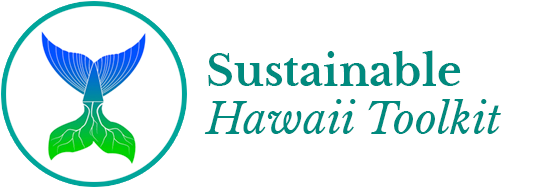Biodiversity
Ua mau ke ea o ka `aina i ka pono
(The life of the land is preserved in righteousness)
Hawaiʻi is often called the “endangered species capital of the world.” The ʻio (Hawaiian hawk), Hawaiian monk seal and Mauna Kea silversword are all endangered species endemic to Hawaiʻi. Each species plays a unique role in our ecosystem and culture. Scientists estimate there’s up to 1 trillion species on Earth, including microbes. More than 99% (five billion) of Earth’s species are estimated to have gone extinct. How do we protect Hawaiian biodiversity from the threats of climate change, invasive species, hunting and population growth? Get active! Read up on Hawaiian flora and fauna. Then join one of the many organizations on the Hawaiian Islands working to maintain our biodiversity by planting trees, protecting honu (turtles), whales and other creatures and leading hikes.
Hawaii Island
Hawaii State
Food Security
Pala ka hala, momona ka hāʻukeʻuke
(When the hala is ripe, the hāʻukeʻuke sea urchin is fat)
Pukui, 1983
Food security means having enough nutritious food to feed everyone all the time. Global challenges like invasive species and our changing climate make food security difficult to achieve anywhere. But especially on the Hawaii Islands. We import 85% of our food—most from the continental United States, a whopping 2,500 miles away.
Everyone needs food to eat, and we shouldn’t have to rely on planes and ships to bring it to us. The good news is that in Hawaii, we can grow our own food year-round. The Kohala Center’s Hawai‘i Island School Garden Network is one of the leaders in Hawaii Island’s flourishing “grown not flown” movement. The earth-loving program teaches our keiki to grow their own food and become stewards of our ‘aina. Other grown not flown Hawaii Island gems include farm training programs, all-local grocery stores, aquaculture programs, school gardening groups and composting programs. Dig in!
Hawaii Island
Hawaii State
National / Federal
Land Use Planning
He ali’i ka ‘āina, he kauwā ke kanaka
(The land is chief; man is its servant)
Pukui, 1983
Hawaii is made up of more than 4.1 million acres, spread across eight main islands. Our lands are sacred and have cultural significance for our people. Our ancestors worked hard to protect our lands. We need to educate ourselves about today’s developments and teach ourselves how to protect our natural resources throughout the Hawaiian Archipelago. Since our island lands are limited, we must carefully plan how to realize our sustainability goals of food security, renewable energy and water management. To manage our sacred lands, grassroots community groups must work with federal and state agencies. You can have a say, too! Just ask the activists at Hawaii’s land trusts, forest stewardship programs and ocean conservation nonprofits. These eco warriors, and others, are working hard to preserve Hawaii’s sacred natural resources. And they need your help! As more of Hawaii’s land is developed, her conservation lands become more vulnerable. So, pull on your work boots and tromp over to a wildlife refuge. If getting dirty ain’t your scene, you can be a voice for the ‘aina at town meetings. Bone up first on the State of Hawaii’s land use plans and priorities! We as a larger lāhui (group) of kiaʻi ʻāina (land stewards) can protect our natural resources.
Hawaii Island
Hawaii State
National / Federal
Water Resource Management
Eia ka wai la, he wai e ola
(Here is the water, the water of life)
Water is especially important for an isolated island chain like Hawaii. 70% of Hawaii’s water goes to agriculture. If we are to increase our food security, we must have reliable water sources. To help grow more local food and simply survive, Lana’i Island, like the Marshall Islands and other Polynesian Islands, is turning towards desal plants. Hawaii Island is surrounded by the Pacific Ocean and has abundant rivers and rain and streams galore. Still, Hawaii Island has 11 climate zones, and we must share water island-wide, from the dry, sun baked Kona-side to the rain drenched Hilo-side. How can we share and effectively manage our water so we all have what we need to thrive? Hawaii’s government and organizations are working to protect our water and watersheds. By 2030, the State of Hawaii hopes to increase our protected watersheds by 30%. American Water Works Association Hawaii Section is dedicated to protecting our drinking water. Coral Reef Alliance is helping decrease wastewater pollution in Puako, on Hawaii Island, and many organizations are cleaning up our watersheds. Contact one of these organizations today to find out how you can help, and plant trees to purify our air and water.
